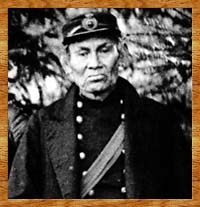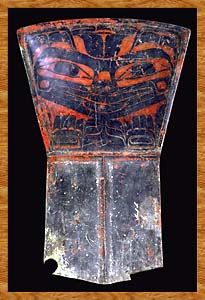 Albert Edward Albert Edward
 Edenshaw Edenshaw
 John Robson John Robson
 Charles Charles
 Edenshaw Edenshaw
 |
Albert Edward Edenshaw
Albert Edward Edenshaw was a living link between the traditional world of the Haida, uninterrupted for centuries, and the chaotic world of the historical era. His achievements as a chief are recorded in the histories of many north coast villages including Kiusta, Dadens, Kung, Yatze, Hiellan and Masset. He has taken on legendary significance, partly because of the numerous if brief references to him in the logs and journals of ships' captains, traders and missionaries throughout much of the nineteenth century. His undisputed contribution was in laying the groundwork for his successors to nurture the fundamentals of Haida culture and assure its survival.

 |
Chief Albert Edward Edenshaw dressed in naval uniform at about eighty years of age. After a long career of warfare, slave trading, art, gold prospecting and possible piracy, he appointed his nephew Charles Edenshaw as his successor and settled down to be a strong supporter of the Methodist Church.
Photograph by Robert Reford, circa 1890.
© National Archives of Canada, C60824 |

Albert Edward Edenshaw, who was born around 1810 south of Rose Spit, inherited the title of Chief Edenshaw about 1832 upon the death of his uncle, the first Chief Edenshaw of Dadens. By this time, Dadens had been abandoned as a permanent village. He moved to Kiusta and built Story House, the decorations for which had come to him in a dream. It is then that he probably honed his own skills as a canoe maker and especially as a craftsman in copper and steel. One of his specialties was elaborately decorated steel war daggers.
In 1853, Albert Edward moved to Kung, where he built House That Can Hold a Great Crowd of People. At the top of the house's frontal pole is a Bear holding two figures: one is a human riding on the back of a Dragonfly. This may represent the vision that he had received in the 1830s when he married a Kaigani Haida woman from Klinkwan, and the town chief asked him to carve a totem pole, an event that launched his career in woodcarving. Alfred Adams, a Masset chief, describes the effect of this early commission:
He got inspiration drinking medicine and he would fast and get his imagination and his conception of different stories and legends. His nephew (Henry) told me that his father never was a carver when young, not a public carver. But once he was visiting in Howkan (Prince of Wales Island) and was hired to make a carving there of a big totem pole . . . When he got to the big tree he visualized then what he was to put on. That is how he started but he had not done very much of this before.
Edenshaw and his clansmen regularly participated in the sea otter and fur seal hunt that yearly took them back to Dadens. The single pole that stood there was carved by Edenshaw and raised in the late nineteenth century next to the house he built there for his second wife, Amy. At the top is a Bear on a stack of seven potlatch cylinders, and below that is the Raven from the story about the halibut fisherman. The next figure is characteristic of his work; it represents the berry picker that the Haida see in the dark pattern of the moon and relates to a myth associated with his wife Amy's lineage. The small Frog hanging below the moon disk is another favourite of the artist and appears on his poles at Kung and elsewhere. Towards the base is a Grizzly Bear with two cubs, one in its mouth and the other between its legs. Another small human figure is crouched between the Bear's knees and stands on the lowest figure, probably a Whale.
The two human figures are exceptionally well carved, more graceful and animated than most Haida depictions of humans. The figure of a woman with long hair on the right-hand post of the house at Klinkwan that belonged to Albert Edward's second son, Henry, is a strong indication that he carved the whole sculptured facade. The elaborate interior carvings inside the house may also be his work, since his characteristic Dragonfly is on the left corner post. The house was probably built in the 1870s.

 |
This very large copper shield, 117 cm (46 inches) high, once belonged to Albert Edward Edenshaw. He was a talented shield engraver and sold his decorated coppers as far south as the Fraser River. This copper portrays his female Grizzly Bear crest.
Purchased from Mary Yaltatse of Masset in 1970.
CMC VII-B-1595 (S92-4312) |

Some time after 1883, Albert Edward moved to Masset. A pair of memorial poles at the northern corner of his house there displayed three important crests. The first pole had a Beaver at the top and the Raven below. The second memorial pole had a standing Frog with potlatch cylinders at the top and a standing Beaver at the base. It is not known whether or not these two poles were carved by either Albert Edward or Charles Edenshaw, or by both.
According to tradition, Albert Edward chose Charles Edenshaw, the son of his sister Qwa'Kuna, to be his successor. When Albert Edward passed away in 1894, Charles not only took over the mantle of Chief Edenshaw but raised the artistic heritage of his famous uncle to new heights.
|